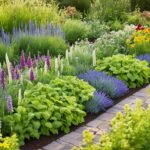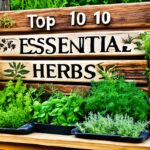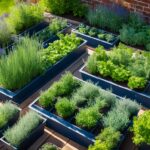Culinary Herbs
Herbal Gardening: Growing and Using Medicinal and Culinary Herbs
Herbal gardening is a journey that brings together nature and health. Imagine a garden full of medicinal herbs and culinary herbs. These plants can boost your health and add flavor to your food. But starting can seem daunting. How do you create an organic and sustainable garden that meets your needs?
This guide will show you how to grow and use herbs. You’ll learn about planning and caring for an herb garden. It will become a key part of your natural health and wellness routine. Whether you’re new to gardening or have years of experience, this journey into herbal gardening will connect you with nature. It will also help you live a more eco-friendly and self-sufficient lifestyle.
Key Takeaways
- Discover the joys and benefits of growing your own medicinal and culinary herbs
- Learn how to plan and design an herb garden that caters to your family’s health needs
- Explore the versatile uses of essential medicinal herbs like Echinacea and Lavender
- Uncover the hidden health benefits of common culinary herbs
- Adopt sustainable gardening practices for a thriving and eco-friendly herb garden
Defining Your Medicinal Herb Garden Needs
Before starting your medicinal herb garden, think about your family’s health needs. Consider common health issues like colds, flu, digestive problems, skin issues, or stress. This helps you pick the right medicinal herbs for your family.
Assessing Your Family’s Health Requirements
Make a list of health issues you want to tackle with your medicinal herb garden. This might be boosting immunity, fighting infections, easing digestive issues, or helping with stress. Knowing your family’s health needs lets you choose the best herbs for natural remedies.
Choosing Herbs Based on Your Climate and Growing Conditions
After picking the health issues to address, find out which herbs will do well in your area. Some herbs are perfect for certain climates. Think about your local temperature, rainfall, and soil type to pick climate-appropriate herbs that will grow well.
For instance, perennial herbs like lavender and echinacea come back every year. Self-seeding annuals like chamomile and calendula often grow back on their own. Research each herb‘s needs to make a diverse and successful medicinal herb garden.
| Herb | Climate Preference | Growing Conditions |
|---|---|---|
| Lavender | Warm, dry climates | Full sun, well-drained soil |
| Echinacea | Temperate, moist climates | Full sun to partial shade, well-drained soil |
| Chamomile | Mild, sunny climates | Full sun, well-drained soil |
| Calendula | Cool, temperate climates | Full sun, well-drained soil |
Think about your family’s health needs and your area’s growing conditions to make a great medicinal herb garden. This garden will give you the natural remedies you need.
Planning and Designing Your Herb Garden
Starting a medicinal herb garden requires careful planning and design. Think about sunlight exposure, soil quality, and available space to make a herb garden layout that lets each plant grow well. Using companion planting techniques can also help. This approach keeps pests away, draws in pollinators, and creates a balanced garden.
Creating a Garden Layout for Optimal Growth
Begin by looking at the growing conditions of your space. Check how much sunlight your garden gets each day. Then, group plants that need the same light and moisture levels together. This way, every herb can grow best in its perfect spot.
- Put taller herbs, like rosemary and lavender, at the back or edges to not shade the smaller plants.
- Use containers or special beds for fast-growing herbs, such as mint and lemon balm, to stop them from spreading too much.
- Place companion plants, like marigolds and nasturtiums, to keep pests away and draw in good insects.
With careful planning and design, your herb garden will be a peaceful, productive spot. It will make the most of optimal growth and prepare you for a great harvest.
Essential Medicinal Herbs to Grow
Starting your medicinal herb garden? Two plants are key: echinacea and lavender. They’re great for your health and well-being.
Echinacea: Boosting Immunity and Fighting Infections
Echinacea is famous for boosting the immune system and fighting off viruses. Its roots have compounds that help prevent colds, flu, and other illnesses. Growing echinacea means you have a natural way to keep your family healthy.
Lavender: A Versatile Herb for Relaxation and Skincare
Lavender is more than just fragrant; it’s also a powerful herb. It has anti-inflammatory properties that are good for your skin. Use it to soothe burns, bug bites, eczema, and acne naturally.
Adding echinacea and lavender to your garden gives you natural remedies and beauty. It’s a step towards a healthier life.
Culinary Herbs with Medicinal Benefits
Culinary herbs add flavor to our meals and also have health benefits. Peppermint is a great example of this. It’s not just for taste; it’s also good for your health.
Peppermint: Soothing Digestive Issues and Headaches
Peppermint is famous for easing digestive troubles like upset stomach, gas, and nausea. Its cooling touch helps calm the stomach, offering relief to those with digestive issues.
Peppermint also helps with headaches and migraines. The menthol in it soothes and numbs the head and neck, easing tension and pain.
| Medicinal Benefits of Peppermint | How It Can Help |
|---|---|
| Digestive Health | Soothes upset stomach, gas, and nausea |
| Headache Relief | Provides a cooling, numbing effect to relieve tension and pain |
Adding peppermint and other herbs to your diet and remedies can boost your health. It’s a smart way to use your herb garden for wellness.
“Peppermint is a versatile herb that can soothe both digestive issues and headaches, making it a valuable addition to any medicinal herb garden.”
Sustainable Gardening Practices
To make a medicinal herb garden thrive, use sustainable gardening methods. Companion planting is a key strategy. It means putting some herbs and plants together to create a balanced garden. This method keeps pests away, draws in pollinators, and keeps plants healthy without harmful chemicals.
Companion Planting for Pest Control and Pollination
By knowing how plants work together, you can make your herb garden self-sustaining. For instance, marigolds near your herbs can keep aphids away. Lavender and rosemary draw in bees and butterflies. This symbiotic approach boosts your garden’s biodiversity and cuts down on chemical use.
- Companion plants like marigolds, lavender, and rosemary can help deter pests and attract pollinators
- Strategically placing plants together creates a balanced, self-sustaining ecosystem
- Sustainable gardening practices reduce the reliance on harmful chemicals and promote plant health
Using sustainable gardening methods, like companion planting, keeps your herb garden productive and eco-friendly. It’s great for you and the local ecosystem for many years.
herbal gardening: A Rewarding Journey
Starting a herbal garden is a journey that can change you deeply. It’s not just about growing medicinal and culinary herbs. It’s about connecting more with nature, becoming more self-sufficient, and taking control of your health with natural remedies.
When you care for your herb garden, you’ll feel the joy of watching plants grow. You’ll love trying out new recipes with herbs and becoming more self-reliant in your health care. Taking care of your herbs, picking their leaves, and using them in your daily life is empowering.
Herbal gardening makes you appreciate nature’s power and its role in your growth and self-sufficiency. It helps you improve your family’s health, cut down on synthetic products, or just connect with the earth. This journey opens up many new possibilities.
“Herbal gardening is not just about growing plants, but about cultivating a deeper understanding of ourselves and our relationship with the natural world.”
Starting your herbal gardening journey means learning, trying new things, and finding the deep benefits of growing your own natural remedies. This journey will make your life richer in many ways.
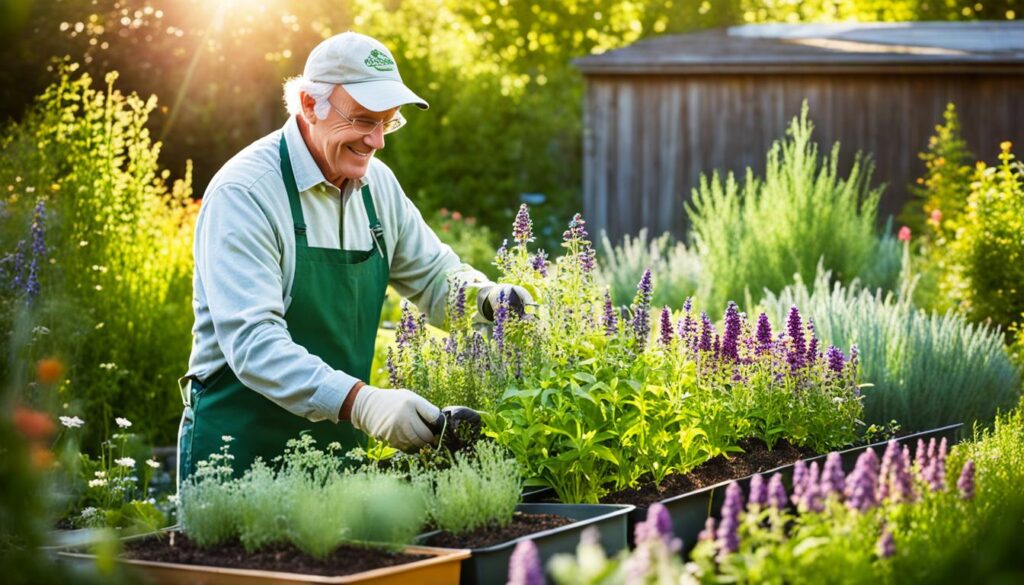
Harvesting and Preserving Your Herbs
Proper herb harvesting and preservation is key to enjoying your herbs all year. Drying and storing herbs well is a great way to keep their flavor and benefits for months.
Drying and Storing Herbs for Year-Round Use
Drying herbs is a simple way to keep their flavor and benefits. When done right, drying herbs keeps their taste, smell, and health benefits for months. This lets you enjoy your garden’s harvest all year.
To dry and store herbs well, follow these steps:
- Harvest herbs just before the flowers bloom, when the oils are strongest.
- Wash and pat the herbs dry, leaving them almost dry.
- Hang them in a cool, dry spot, or use a dehydrator at the right temperature.
- Once dry, put them in airtight containers, like glass jars or bags, away from light and heat.
By drying and storing herbs right, you can use them all year in many recipes and remedies.
“Drying herbs is a simple yet efficient way to preserve their potent medicinal and culinary properties.”
| Herb | Drying Time | Storage Conditions |
|---|---|---|
| Lavender | 7-10 days | Cool, dark place |
| Rosemary | 5-7 days | Airtight container |
| Thyme | 3-5 days | Sealed jar or bag |
Creating Herbal Remedies at Home
Learn to make your own herbal remedies at home with your medicinal herb garden. You can turn your herbs into herbal teas, tinctures, and salves. These natural healing products can be made at home. This lets you create remedies that fit your family’s health needs.
Tinctures, Salves, and Teas for Natural Healing
Tinctures are strong extracts made from herbs soaked in alcohol or vinegar. They help with many health issues, like boosting immunity or reducing inflammation. Salves are creams made with herbs, oils, and beeswax. They’re great for skin and muscle care.
Herbal teas are a tasty way to use medicinal herbs every day. They can help with digestion or help you relax. The right herbs can offer natural healing.
- Craft your own unique herbal remedies using the herbs you’ve grown
- Discover the versatility of tinctures, salves, and herbal teas for natural healing
- Tailor your herbal preparations to address your family’s specific health needs
“The true medicine of the future will be the utilization of the healing powers of nature.” – Henry Lindlahr
Enjoy making your own herbal remedies and use your medicinal herb garden’s healing power. With practice and creativity, you can support your family’s wellness with the plants you’ve cared for.
Incorporating Herbs into Your Diet
Using medicinal herbs isn’t just for health issues. You can also add them to your daily meals for their nutritional benefits. Herbs like rosemary, thyme, and basil make food taste great and are packed with antioxidants and anti-inflammatory compounds. Adding herbs from your garden to your cooking is a tasty way to boost your health.
Herbs fit into many dishes, from soups to salads and main courses. Adding herb-infused recipes to your meals can bring both culinary and medicinal benefits. This makes your meals more enjoyable and healthy.
- Sprinkle fresh basil or oregano on your homemade pizza for a burst of flavor and antioxidants.
- Incorporate rosemary or thyme into roasted vegetables for an anti-inflammatory boost.
- Add a handful of chopped parsley or cilantro to your favorite pasta dish for a nutrient-rich garnish.
| Herb | Culinary Use | Medicinal Benefits |
|---|---|---|
| Rosemary | Roasted meats, potatoes, and vegetables | Antioxidant, anti-inflammatory, may improve cognitive function |
| Peppermint | Teas, smoothies, and desserts | Soothes digestive issues, may relieve headaches |
| Turmeric | Curries, rice dishes, and marinades | Powerful anti-inflammatory properties, may support joint health |
Trying out different culinary herbs in your cooking is an easy way to boost your diet’s nutritional benefits. Enjoy the taste and health perks these plants offer.
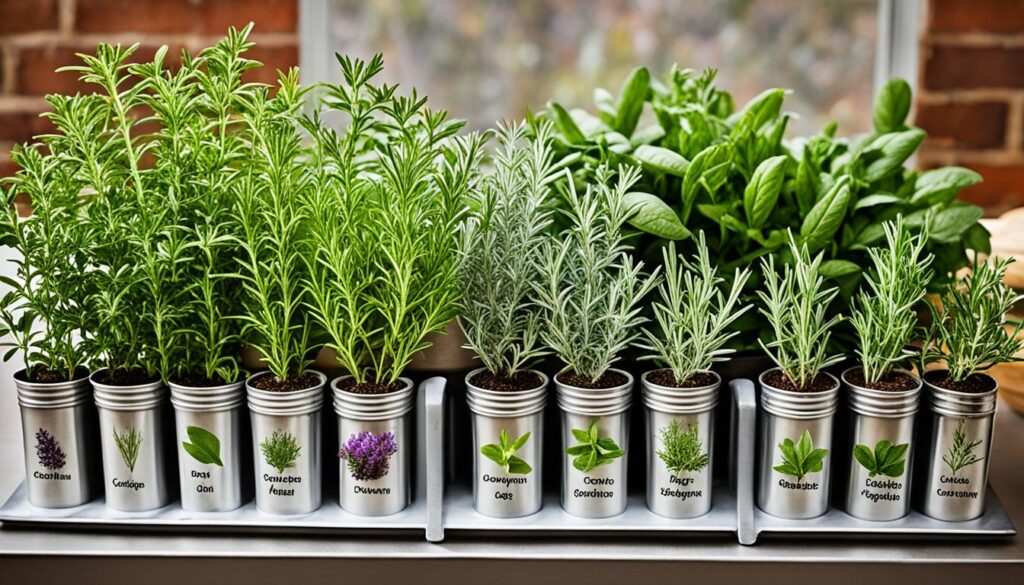
Troubleshooting Common Herb Garden Issues
Keeping a medicinal herb garden healthy means watching over it closely and fixing problems fast. You might face pests or diseases that can harm your herbs. By paying attention to your plants and using green solutions, you can beat these issues and keep your garden thriving.
Identifying and Treating Pests
Pests can pop up in any garden, including your herb garden. Aphids, spider mites, and slugs can damage your herbs. To fight these pests, try organic ways like adding beneficial insects, using neem oil, or making insecticidal soap at home.
Managing Plant Diseases
Your herbs might also get sick with things like powdery mildew or fungal infections. Catching these problems early and treating them quickly is crucial. Use green disease control methods, like cutting off sick leaves, improving air flow, and natural fungicides like copper or sulfur.
By being watchful and using organic solutions for pest control and disease management, your herb garden will stay healthy and full of life. With some care, your medicinal herbs will keep growing well, giving you lots of natural remedies.
“The key to a healthy, productive herb garden is understanding and addressing any challenges that arise, using sustainable and eco-friendly methods.”
Expanding Your Herbal Knowledge
Starting your herbal gardening journey means always learning more. It helps you understand and value the plants you grow. Look for good books, online courses, and expert advice to learn about herb properties and herb uses. Working on your own and teaming up with skilled herbalists can make you better at using your herb garden. This can help you use these natural remedies every day.
Resources for Learning About Herb Properties and Uses
To grow your herbal knowledge, check out these herbal resources:
- Comprehensive herbal reference books that delve into the history, science, and applications of various medicinal plants
- Online courses and webinars led by reputable herbalists and experts in the field
- Local herb workshops and community classes that provide hands-on learning experiences
- Joining herbal enthusiast groups, either in-person or online, to network and exchange knowledge with fellow herb gardeners
- Subscribing to herbal publications and blogs that offer the latest insights and research on herb properties and herb uses
By always learning more through self-study and using these herbal resources, you can really appreciate the complex world of medicinal herbs. This can help you get the most out of your herb garden.
Conclusion
Herbal gardening is a rewarding way to grow your own medicinal and culinary herbs. It’s a natural way to improve your health and your family’s well-being. By planning and designing your garden well, you can make a space that helps your body and spirit.
As you learn more about herbs, you’ll find joy in using them in your daily life. These plants can boost your health, soothe stomach issues, and make your food taste better. They can change how you feel and help you take control of your health.
Starting your herbal gardening journey is exciting, whether you’re new or experienced. You’ll feel more alive, independent, and connected to nature. Growing your own medicinal herbs and culinary herbs brings many benefits. It’s a chance to embrace natural wellness and self-sufficiency.
FAQ
What are the benefits of growing a medicinal herb garden?
Growing a medicinal herb garden lets you use herbs for health. It’s a natural way to improve your family’s wellness. You can make your own herbal remedies.
How do I choose the right herbs for my garden based on my climate and growing conditions?
Pick herbs that do well in your area’s climate and soil. Think about how much sun your garden gets and how much space you have. Choose a mix of herbs that grow well together.
What are some key design considerations for planning an optimal medicinal herb garden layout?
Plan your garden carefully to make the most of your space. Think about how much sun each plant needs and the soil quality. Use companion planting to keep pests away and attract bees.
What are the medicinal benefits of growing herbs like echinacea and lavender?
Echinacea boosts the immune system and fights infections. Lavender calms the skin and reduces inflammation. These herbs can help your family stay healthy naturally.
How can I use culinary herbs like peppermint for their medicinal properties?
Culinary herbs like peppermint are also good for health. Peppermint eases digestive issues and helps with headaches. Use these herbs in your cooking and remedies for better health.
What are some sustainable gardening practices I can implement to maintain a thriving medicinal herb garden?
Use sustainable gardening like companion planting to keep pests away and attract bees. This approach keeps your garden healthy without harmful chemicals. It makes your garden good for the environment and your plants.
How do I properly harvest and preserve my medicinal herbs for year-round use?
Harvest and dry your herbs to keep them fresh all year. Drying is a great way to store herbs for teas and remedies. Keep your herbs dry and stored right to keep their healing powers.
What are some common challenges I may face in maintaining a medicinal herb garden, and how can I address them?
Your herb garden might face pests or diseases. Use organic methods to solve these problems. Know what’s wrong with your plants and use safe remedies to fix them. This way, you can keep your garden healthy and enjoy its benefits.
Source Links
- https://melissaknorris.com/how-to-plan-a-medicinal-herb-garden/ – Medicinal Herb Garden (Planning and Growing)
- https://homesteadingfamily.com/medicinal-herbs-their-uses/ – Medicinal Herbs & Their Uses
- https://www.libertymissionfarms.com/post/medicinal-and-culinary-herb-garden – Medicinal and Culinary Herb Garden
Top 10 Essential Herbs for Your Garden and Their Uses
Want to boost your cooking skills and turn your garden into a lively spot of tasty herbs? You’re in the right place! Herb gardens are simple to maintain and very rewarding. They give you a lot of fragrant leaves that can make any dish better. Whether you’re a pro in the kitchen or just starting, learning to grow and use fresh herbs can change the game. But where do you start?
In this detailed guide, we’ll look at the top 10 essential herbs for your garden. We’ll also cover their many uses in cooking and medicine. From the best herbs to grow for beginners to the most useful herbs for experts, we’ve got everything you need. Get ready to learn how to grow culinary herbs and versatile herbs that will take your cooking to the next level and improve your health.
Key Takeaways
- Herb gardens offer an easy and rewarding way to grow your own fresh, flavorful ingredients.
- Mastering the art of growing and using herbs can transform your cooking and overall well-being.
- This guide will explore the top 10 essential herbs for your garden and their diverse culinary and medicinal applications.
- Whether you’re a beginner or a seasoned gardener, you’ll learn the best herbs to grow and how to use them to their fullest potential.
- Discover the secrets to cultivating a thriving herb garden and unlocking the versatility of these aromatic plants.
Introduction to Culinary Herbs
Easy herbs for beginners like culinary herbs are great to grow. They add flavor to many dishes and need little care. This makes them perfect for both new and experienced gardeners. Growing your own culinary herbs at home has many benefits.
The Benefits of Growing Fresh Herbs at Home
Having fresh herbs for your garden is a big plus for cooks. It makes them feel like pros when they use these herbs. Plus, you always get the freshest, tastiest herbs for your cooking.
Tips for Beginner Herb Gardeners
- Start with easy herbs for beginners like basil, mint, or chives. They grow fast and are easy to care for.
- Choose a spot in your garden or on your patio that gets at least 6 hours of sunlight daily. Herbs for your garden love the sun.
- Take care of your herb garden essentials. Use well-draining soil and water them regularly to keep them healthy.
- Try growing growing culinary herbs you use often in your cooking. This will make your meals even better.
With a little care, you can create a beautiful herb garden. It will make your cooking better and give you fresh herbs all year.
Basil: The King of Summer Herbs
Few herbs are more linked to summer than basil. It’s a favorite in many cuisines, especially in Italian cooking. You’ll find it in sauces and salads. This top kitchen herb is essential for any herb garden.
Growing and Caring for Basil Plants
Basil is a delicate culinary herb that doesn’t last long in cooking. Keep it in a small pot on your porch and cut it often to stop it from seeding. To keep fresh-cut basil, put the stems in a jar with water, and cover it with a plastic bag.
Culinary Uses of Fresh Basil
Add basil to salads for a burst of summer taste. It’s great with tomatoes, fresh mozzarella, and olive oil for a caprese salad. Or, mix it with olive oil and pine nuts for homemade pesto. Its unique flavor makes it a key cooking herb for many dishes.
“Basil is the king of garden herbs – its bright, peppery flavor is a must-have for any home cook.”
Rosemary: An Aromatic Evergreen Delight
Looking for the best herbs for your garden? Rosemary is your answer. This evergreen herb is a favorite among cooks for its unique, piney flavor. It’s been used for centuries in cooking, perfumes, and personal care products.
Rosemary is versatile and strong. Unlike delicate herbs like basil, it can handle long cooking times. It’s perfect for soups, stews, roasts, and more. Plus, it’s easy for beginners to grow indoors or outdoors.
Rosemary can grow into a small shrub, adding beauty and scent to your garden. But, it might not make it through winter in cold places. To keep it alive, bring it inside during the cold months. Place it near a window with a bit of cold air coming in.
“Rosemary is for remembrance; therefore, my brief absence, be forgotten by you.”
– William Shakespeare
Rosemary is essential for any herb garden, whether you’re a pro or a beginner. Its scent and versatility make it a joy for cooks and gardeners alike.
Thyme: A Hardy Herb for Various Dishes
If you want to add a unique flavor to your cooking, thyme is a great choice. It’s a hardy herb that grows well in dry soil. You can use it in many dishes, making it a top pick for kitchen herbs.
Growing and Harvesting Thyme
Thyme is tough and can handle drought and some foot traffic. Plant it in a sunny spot with good drainage. It needs little care and you can pick its leaves or stems as you need them.
Culinary Applications of Thyme
Thyme has a strong, piney taste that’s great in many dishes. Use it in soups, stews, and on meats for added flavor. You can also add it to veggies at the end of cooking or make a tasty syrup for drinks.
“Thyme is a must-have herb for any home cook who loves to experiment with bold, earthy flavors.”
Thyme is perfect for gardeners at any level. Adding it to your cooking can take your dishes to the next level. It’s a great way to explore the world of herbs.
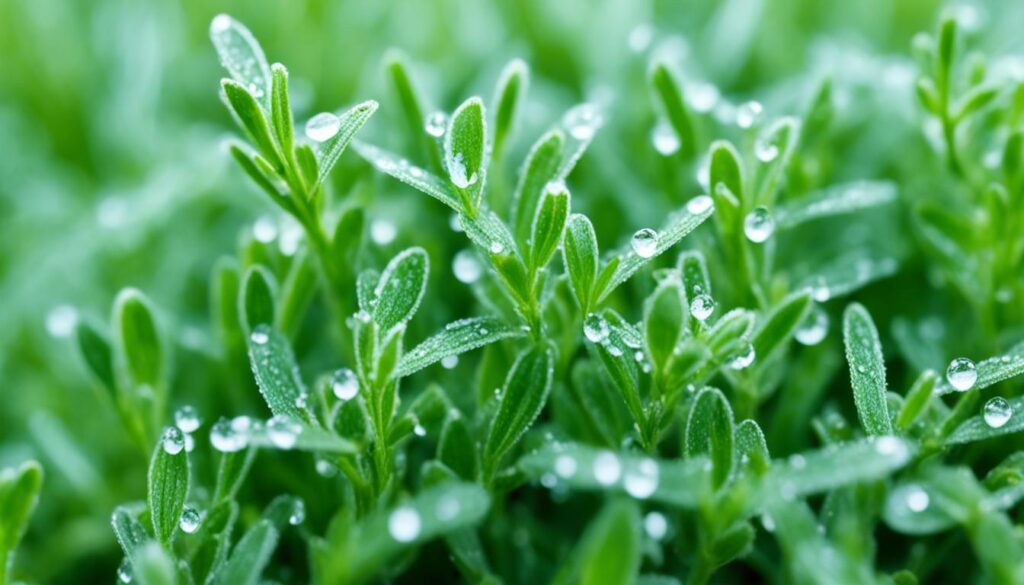
Mint: A Refreshing Addition to Drinks and Desserts
Mint is a top choice for your garden, adding a fresh touch to many dishes and drinks. This culinary herb is famous for its cool taste that wakes up your taste buds.
Mint’s magic comes from its menthol content. This chemical makes our mouths feel cool, refreshing us in a unique way. That’s why mint is a favorite for summer drinks and sweets.
Mint is easy to grow and does well in the shade with lots of water. But, it can spread fast, taking over your garden. Growing it in pots helps keep it in check and lets you enjoy its perks without the hassle.
Versatile Uses of Mint
- Add fresh mint leaves to iced tea, lemonade, or fruit-infused water for a refreshing twist.
- Incorporate mint into summery desserts like mint chocolate chip ice cream, mojito sorbet, or mint-infused whipped cream.
- Use mint to garnish summer salads, grilled meats, and vegetable dishes for a pop of flavor and aroma.
- Craft creative cocktails by muddling mint leaves with other ingredients like lime, rum, or vodka.
- Dry or freeze mint leaves to enjoy their culinary benefits throughout the year.
Looking to brighten your drinks, desserts, or meals? Growing mint in your garden ensures you always have this versatile herb for cooking on hand.
Essential Herbs for Your Garden
Creating a garden with herbs is fun and rewarding. It doesn’t matter if you’re new to gardening or have years of experience. Growing a variety of herbs can make your cooking better and improve your health. Let’s look at some top herbs that are great for cooking and health.
Versatile Herbs for Cooking and Medicinal Uses
Some herbs are amazing in the kitchen and for health. Here are some top herbs you should grow in your garden:
- Basil – This herb is full of flavor and adds a fresh taste to dishes. It also has healing properties and can help with different health issues.
- Rosemary – Known for its strong scent, rosemary is a key herb in many dishes. It can boost memory and reduce swelling.
- Mint – Mint is refreshing and versatile, great for drinks, desserts, and meals. It’s also used for health, easing digestive problems and freshening breath.
- Lavender – Lavender is not just a pretty herb, it’s also calming. It helps with sleep and relaxation.
Tips for Growing a Variety of Herbs
To grow a successful herb garden, you need some knowledge and care. Here are tips to help you:
- Choose a spot that gets a lot of sun and has good drainage. Most herbs love the sun.
- Think about using raised beds or containers. They let you control the soil and drainage better.
- Water your herbs often, but don’t overdo it. Too much water can cause root rot.
- Trim and pick your herbs often to keep them healthy and full.
- Try different herbs and see which ones you like best for cooking and health.
Growing a variety of herbs can make your cooking better, improve your health, and create a lovely garden. It’s a great way to enjoy your garden.
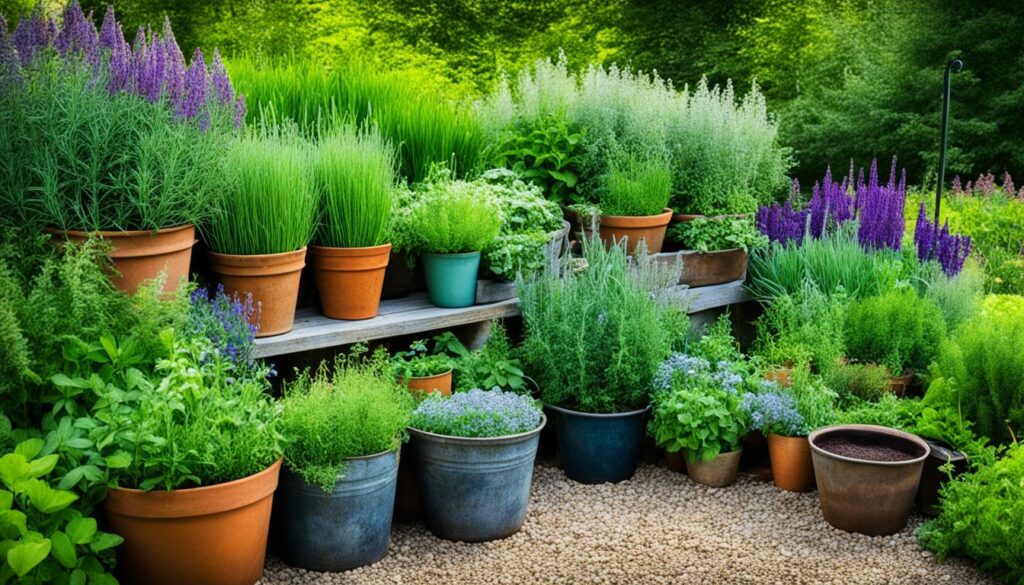
Oregano: The Pizza Herb
If you love Mediterranean food, you should grow oregano in your garden. It’s known as the “pizza herb” for its use on pizza and in sauce. Oregano has an earthy taste that goes well with meats and veggies. When dried, its flavor gets even stronger, making it great for your kitchen.
Growing Oregano in Pots and Gardens
Oregano does well in full to partial sunlight and likes dry soil. It’s perfect for a terracotta pot because they help with drainage. Being related to marjoram, oregano is also a top choice for your best herbs to grow for cooking.
Using Oregano in Mediterranean Dishes
Oregano’s bold flavors are perfect for Mediterranean dishes. Add it to tomato soup or make a simple sauce with olive oil, garlic, lemon, and salt. Serve it over chicken or fish. You can also dry oregano and keep it in a sunny spot for easy access.
“Oregano is the queen of the herb garden. It’s the most flavorful and aromatic of all the herbs.”
Oregano is a must-have for gardeners of all levels. Its strong flavor and versatility make it a go-to herb for many dishes. It’s a key part of herbs for cooking that you’ll use often.
Parsley: A Nutritious Garnish and More
Parsley is a top choice among the best herbs to grow. It’s known for its slightly bitter, grassy taste. This makes it perfect for many dishes, like salads and sauces.
This herb grows fast and does well in gardens or pots. It’s great for beginners. Parsley is full of vitamins, minerals, and antioxidants. These nutrients help prevent cancer, improve urine flow, strengthen bones, and support eye health.
Parsley is also a versatile herb for cooking. Use it as a garnish or add it to salads, sauces, and more. If you have too much, store it in a jar of water in the fridge. It will stay fresh for a few days.
Whether you’re a pro at gardening or just starting, parsley is essential for your kitchen. It’s easy to grow, nutritious, and useful in many recipes. Parsley is a top choice for any kitchen herb garden.
Chives: The Mild Onion Flavor
Chives are a top choice for gardeners looking to grow herbs. They belong to the onion family and bring a light, garlicky taste. This makes them perfect for many culinary herbs and popular garden herbs. Chives are great for adding flavor to your cooking and are among the best herbs to grow.
Growing and Harvesting Chives
Chives are easy to grow and are perfect for new herb gardeners. They love full sun and well-drained soil. You can even grow them in pots on your patio or balcony. To get your chives, just cut the green stems with scissors, leaving some growth for the plant.
Culinary Uses of Fresh Chives
Chives add a mild onion taste to many dishes. Use them on baked potatoes, creamy soups, or in omelets and quiche. You can mix chives into cream cheese for a tasty bagel topping. Or, use them as a garnish to brighten up your meals.
“Chives are a great way to add a mild garlicky flavor to almost any dish.”
Conclusion
Herb gardens bring joy and benefits to any home. They offer fresh, flavorful ingredients for cooking and health benefits. By growing herbs like basil, rosemary, thyme, mint, and chives, you can boost your cooking and health.
These herbs are great for both experienced herb gardeners and beginners starting their first herb garden essentials. The guide helps you pick, grow, and use these popular garden herbs well.
Adding herbs for cooking to your meals makes them taste better. They also offer health benefits. Herbs like rosemary and mint can change your cooking and help your health.
Whether you like easy herbs for beginners or want to grow more growing culinary herbs, herb gardening is rewarding. With the right guidance, you can make a herb garden that inspires and delights you in the kitchen and beyond.
FAQ
What are the best herbs to grow for beginners?
Great herbs for beginners include basil, rosemary, thyme, mint, oregano, parsley, and chives. They’re easy to grow and versatile. Plus, they need little care.
What are the essential herbs for a home herb garden?
Essential herbs for a home garden are basil, rosemary, thyme, mint, oregano, parsley, and chives. They’re key in cooking and have many uses.
How can I use fresh herbs in my cooking?
Use fresh herbs to boost your dishes’ flavors. Add them to salads, soups, stews, roasts, sauces, and drinks. Basil, oregano, and thyme go great with tomatoes. Mint and chives add a fresh touch.
What are the health benefits of growing and using herbs?
Herbs are full of medicinal properties, offering health perks. Rosemary and thyme have antioxidants, mint helps with digestion, and parsley is packed with vitamins and minerals. Growing your own herbs means you always have these plants on hand.
How do I care for my herb garden?
Taking care of an herb garden means giving them sunlight, water, and sometimes pruning or harvesting. Rosemary and thyme like dry conditions, while mint prefers more moisture. Harvesting your herbs often helps them grow and produce more.
Can I grow herbs indoors?
Yes, many herbs thrive indoors in pots or containers. Basil, thyme, rosemary, and chives are good choices. Ensure they get enough sunlight, either from a sunny window or a grow light.
What are some creative ways to use fresh herbs?
Use fresh herbs in more than just cooking. Make herb-infused oils or vinegars, add to salad dressings or marinades, flavor syrups for cocktails or lemonade, or mix into baked goods like breads or cookies.
Source Links
- https://franksnurseryandcrafts.com/12-essential-herbs-for-your-kitchen-garden/ – 12 Essential Herbs for Your Kitchen Garden – Franks Nursery
- https://chestnutherbs.com/the-top-ten-medicinal-herbs-for-the-garden/ – The Top Ten Medicinal Herbs for the Garden: How to Grow & Use Healing Plants
- https://plantlife.ie/10-must-have-herbs-for-your-garden/ – 10 Must Have Herbs for Your Garden – Urban Plant Life
A Step-by-Step Guide to Planting Herbs in Your Garden
Are you ready to boost your cooking skills by growing your own fresh herbs? Imagine the joy of picking fragrant leaves from your backyard or windowsill for your dishes. We’ll guide you through planting and caring for a thriving herb garden. This is perfect whether you have a small space or a big outdoor area. Get ready to explore a world of flavor with homegrown herbs!
Key Takeaways
- Herbs are easy to grow and can elevate your cooking
- Learn how to choose the right herbs for your garden and planting conditions
- Discover the steps to prepare the soil and plant herbs in garden beds or containers
- Uncover tips for caring for your herb garden and harvesting your bounty
- Explore methods to preserve your fresh herbs for year-round use
Introduction to Growing Herbs
Herbs add flavor and benefits to any garden. They are great for cooking, medicine, and making your home smell nice. Whether you’re new to gardening or have been doing it for years, learning about types of herbs and growing your own herbs is key. It helps you make a garden that improves your cooking and health.
Types of Herbs
There are two main types of herbs: annual herbs and perennial herbs. Annual herbs like basil and cilantro live only one season and need to be replanted every year. Perennial herbs, such as rosemary and thyme, are woody plants that can live for many seasons.
Benefits of Growing Your Own Herbs
Growing your own herb garden has many advantages. Homegrown herbs taste better, are more nutritious, and are better for the planet. It’s also cheaper and ensures you always have your favorite herbs on hand.
Learning about the types of herbs and benefits of herb gardening helps you start a successful homegrown herb garden. This garden will give you fresh flavors and health benefits all year.
Choosing the Right Herbs for Your Garden
Choosing the right herbs for your garden means picking the ones you’ll use in your cooking. Don’t plant more than you can use. Start with popular herbs like rosemary, oregano, basil, and thyme. These are the common culinary herbs you’ll use often.
As you get more experience, add other versatile herbs to grow that fit your cooking style. Make sure your herb garden is not too big or too small. It should be just right for your needs.
Think about sunlight, water, and how each herb grows when selecting herbs for garden. Some herbs need full sun, while others like shade. Mint can spread fast, so keep it in containers to control it.
| Herb | Sunlight Needs | Water Needs | Growth Habit |
|---|---|---|---|
| Basil | Full Sun | Moist, Well-Drained | Bushy |
| Rosemary | Full Sun | Drought-Tolerant | Trailing/Spreading |
| Thyme | Full Sun | Dry to Average | Trailing/Spreading |
| Mint | Partial Shade | Moist | Aggressive Spreader |
Think about what each herb needs to make a garden that’s full of life and flavor. This way, you’ll always have fresh herbs for your cooking.
Preparing the Soil for Herb Planting
Healthy herbs need well-drained, rich soil to grow well. To make the best soil, you must prepare it before planting. Adding the right stuff to the soil helps your herbs start strong.
Soil Amendments for Herb Gardens
Adding organic matter is key to preparing soil for herbs. It makes the soil better at draining water, letting air in, and giving nutrients. A good mix for planting herbs is half topsoil, half compost, and some coarse sand. Adding a little earthworm castings gives extra nutrients.
- Mix in 2-3 inches of compost or Scotts Performance Naturals Soil Improver to amend soil for herb garden
- Blend in a handful of earthworm castings for extra nutrients
- Make sure the soil drains well for ideal soil conditions for herbs
Getting the soil mix for herb planting right is key for healthy herbs. By improving soil for herb growth, you help your plants succeed from the start.
| Soil Amendment | Benefits for Herb Gardens |
|---|---|
| Compost | Improves soil structure, drainage, and nutrient content |
| Coarse Sand | Enhances drainage and aeration |
| Earthworm Castings | Provides a natural, slow-release source of nutrients |
Planting Herbs in Garden Beds
Planting herbs in your garden is a great way to make your garden useful and fun. This guide will help you grow herbs outside and arrange your garden for the best results.
Choosing the Right Location
Choosing the right spot is key for herbs to grow well. Pick a place that gets at least 6 hours of sunlight a day. Herbs do well in soil that drains well, so stay away from wet areas.
Preparing the Soil
Before setting up your herb garden, improve the soil. Add compost or other organic stuff to make it richer and better at draining. Make sure the soil’s pH is right for the herbs you want to grow.
Planting Your Herbs
- Take the herb plant out of its pot carefully to avoid hurting the roots.
- Dig a hole a bit bigger than the root ball and put the plant in at the same depth as before.
- Fill the hole with soil and press it down to get rid of air pockets.
- Water the plant well to help it settle.
- Give it a balanced fertilizer, like Scotts Osmocote Pour+Feed, for nutrients.
Keep your herb garden healthy by watering it often, adding compost or fertilizer when needed, and trimming it to keep it bushy and prevent it from flowering. Flowering can make the leaves taste bad.
By doing these steps, you’ll have a great outdoor herb garden. It will give you lots of fresh, tasty herbs for your cooking.
Planting Herbs in Containers
Growing herbs in your garden is great, but growing herbs in pots is also a smart choice. It lets you have fresh herbs right by your door. Plus, it means less work and fewer pests.
Selecting the Right Containers and Potting Mix
Choosing the right pot is crucial for herb container gardening. Pick a container big enough for your herbs to grow and make sure it has good drainage holes. A special potting mix for veggies and herbs is a must. It gives your herbs the right nutrients and drainage.
To plant your herbs, carefully take them out of their original pot. Put them in the new pot and fill in with potting mix. Water well and use a liquid fertilizer like Scotts Osmocote Pour+Feed to help them grow strong.
| Best Pots for Herbs | Ideal Potting Soil |
|---|---|
|
|
Choosing the right containers and soil will help your herbs grow well.
Caring for Your Herb Garden
Maintaining a thriving herb garden takes a bit of effort, but it’s worth it. By following simple steps, you can keep your homegrown herbs healthy and ready for cooking. This ensures you always have fresh herbs for your meals.
To keep your herbs healthy, start with rich soil. Add compost or soil improver every year to enrich the soil. This keeps your herb garden healthy and full of herbs.
It’s important to water your herbs right. Water the soil, not the leaves, and give new plants extra moisture. As they grow, you can water less but always check the soil to avoid drying out.
Herbs also need a slow-release vegetable and herb fertilizer each season. This gives them the nutrients they need to stay healthy and full of flavor.
Don’t forget to prune or pinch back your herbs often. This makes them bushy and stops them from flowering too early. This keeps them productive longer.
With these simple tips, you’ll get a lot of flavorful herbs from your garden. This will make your cooking taste amazing.

| Herb Garden Care Tip | Why It’s Important |
|---|---|
| Add compost or soil improver annually | Enriches the soil and replenishes nutrients for healthy, thriving plants |
| Water regularly, focusing on the soil | Ensures plants receive adequate moisture, especially for newly established herbs |
| Use a slow-release vegetable and herb fertilizer | Provides ongoing nutrition to support vigorous growth and abundant harvests |
| Prune or pinch back herbs frequently | Encourages bushy, compact growth and prevents premature flowering/seeding |
Follow these tips for thriving herb plants to keep your herb garden healthy and full of herbs. You’ll have fresh, flavorful herbs all season.
Planting herbs guide
Planting and growing herbs at home is simpler than you might think. Whether you choose garden beds or containers, this herb planting guide will help you every step of the way.
Start by preparing the soil for your herbs. Add organic matter like compost or manure to make the soil rich in nutrients. This helps your herbs grow strong.
- Pick the right herbs for your garden, considering your climate, space, and what you like.
- Find out the best planting depth and spacing for each herb, as they differ.
- Plant your herbs in a spot that gets enough sunlight and has good drainage.
- Water your herbs often, adjusting the amount based on the weather and their needs.
- Keep your herb garden healthy with pruning and weeding.
By following these step-by-step instructions for planting herbs, you’ll soon enjoy fresh, tasty herbs from your garden or patio. Start your herb growing journey today for a bountiful harvest.
“Herbs not only add flavor to our meals, but they also have a wide range of health benefits. Growing your own herb garden is a rewarding and practical way to enjoy these amazing plants.”
Harvesting and Preserving Your Herbs
Properly harvesting herbs and keeping them fresh is key to enjoying their full flavor and scent. Whether for cooking, medicine, or garden decoration, knowing how to harvest herbs and keep them fresh is essential.
Tips for Harvesting Herbs
The best time to harvest herbs is just before they flower, when their essential oils are strongest. Here are some tips for a great harvest:
- Harvest herbs in the morning, after the dew dries and before it gets too hot.
- Use clean, sharp scissors or pruners to cut off leaves or stems, leaving 2-3 inches on the plant.
- Avoid taking more than one-third of the plant to keep it healthy and growing.
- Know the when to harvest herbs – each type has its best time.
Methods for Preserving Fresh Herbs
After harvesting your herbs, explore ways to keep them fresh and tasty. Here are some good methods:
- Drying herbs: Hang them in a place with good air flow, or use a food dehydrator.
- Freezing herbs: Put them in ice cube trays with water or stock, or spread them on a baking sheet and put them in airtight bags once they’re frozen.
- Preserving herbs in oil or vinegar: Make herb-infused oils or vinegars to enjoy their flavor later.
- Making herb pesto or sauces: Blend fresh herbs with olive oil, nuts, and other ingredients to make tasty condiments that freeze well.
| Herb | Best Time to Harvest | Preservation Method |
|---|---|---|
| Basil | Just before flowering | Drying, Freezing, Pesto |
| Rosemary | Spring and early summer | Drying, Infused Oils |
| Thyme | Just before flowering | Drying, Infused Vinegars |
Learning how to harvest herbs and use herb preservation techniques lets you enjoy your homegrown herbs all year round.
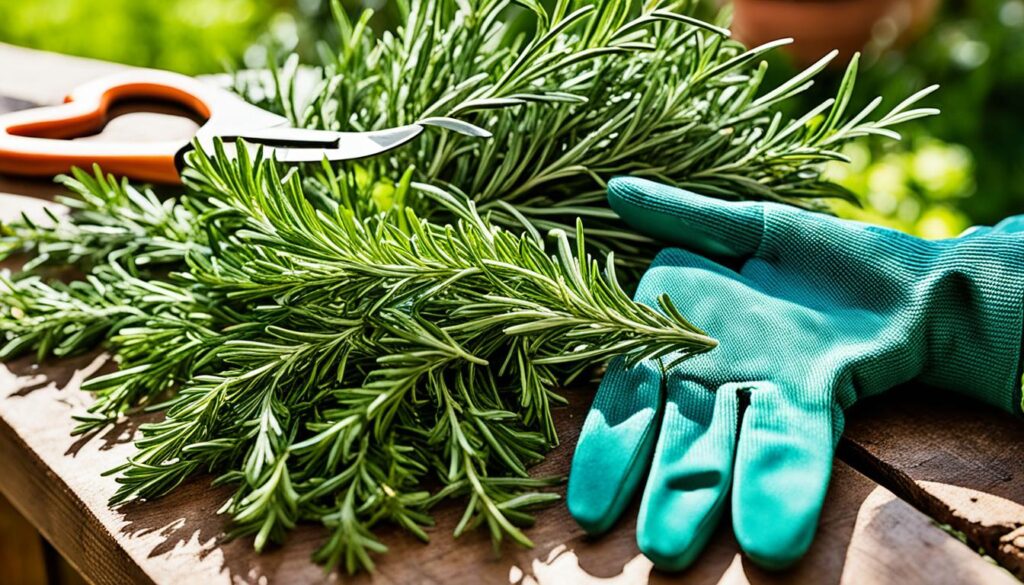
Conclusion
Starting your own herb garden at home is both rewarding and practical. It can make your cooking much better. This guide has given you the knowledge and skills to create a great herb garden that fits your needs.
You now know how to pick the right herbs for your cooking and prepare the soil for them. You also know how to give your herbs the best growing conditions. This means you can have a beautiful herb garden at home.
Homegrown herbs add fresh, vibrant flavors to your cooking and are good for your health. You can enjoy these benefits right in your own backyard or on your patio. Whether you’re experienced or new to gardening, starting an herb garden is a great way to connect with nature and improve your cooking skills.
This guide will help you on your herb-growing journey. It will help you enjoy the many benefits of having herbs you grew yourself.
FAQ
What are the two main types of herbs?
There are two main types of herbs. Annual herbs like basil die after one year. Perennial herbs, such as rosemary, live for many years because they are woody shrubs.
What are the benefits of growing your own herbs?
Growing your own herbs is great. You get fresh, flavorful herbs for cooking. They are easy to grow and healthier than store-bought ones.
How do I choose which herbs to grow?
Start with herbs you use most in cooking. This includes rosemary, oregano, basil, and thyme. As you gain experience, add more herbs you like to your garden.
How do I prepare the soil for planting herbs?
Prepare the soil well before planting herbs. Add organic matter like compost or Scotts Performance Naturals Soil Improver. A good mix is equal parts topsoil, compost, and coarse sand.
How do I plant herbs in garden beds?
Choose a spot that gets at least 6 hours of sunlight daily for planting herbs in garden beds. Prepare the soil as before. Put the herb plant in the hole at the same depth as before, and fill with soil. Press it down and water well with Scotts Osmocote Pour+Feed.
How do I plant herbs in containers?
Herbs do well in containers too. Pick a pot that fits the herb’s mature size. Use a premium potting mix for vegetables and herbs. Put the herb in the pot and fill with mix. Water with Scotts Osmocote Pour+Feed to help it settle.
How do I care for my herb garden?
Keep your herbs healthy by adding compost or soil improver every year. Water them well, especially when they’re new. Use a slow-release fertilizer each season. Prune them often to keep them bushy and prevent flowering.
How do I harvest and preserve my herbs?
Pick herbs often to keep them bushy. Use the leaves and stems as you need them. Harvest just before using for the best flavor and freshness.
To preserve herbs, dry them by hanging or using the oven on low heat. Freezing is also good – put leaves on a baking sheet and move to airtight bags once frozen.
Source Links
- https://www.gardenary.com/blog/how-to-start-an-herb-garden – How to Start an Herb Garden • Gardenary
- https://www.gardenary.com/blog/the-ultimate-guide-to-growing-herbs – The Ultimate Guide to Growing Herbs • Gardenary
- https://www.lovethegarden.com/au-en/article/beginners-guide-growing-herbs – The Ultimate Beginners’ Guide to Growing Herbs
Herbal Gardens for Beginners: Essential Herbs and Their Uses
Are you ready to make your cooking and wellness routine better with fresh, homegrown herbs? Starting a herbal garden is a rewarding journey. It brings nature’s flavors and healing properties right to your doorstep. This guide will help you create a thriving oasis of essential herbs at home.
Imagine stepping out to your patio and picking fresh basil for your pasta sauce. Or harvesting calming chamomile for your evening tea. With a bit of sunlight and care, you can grow many herbs. These herbs will make your cooking better and support your health. Let’s start this exciting green adventure and enjoy the joys of your own herbal garden.
Introduction to Herbal Gardening
Herbal gardening is a hobby that brings healing power from nature right to your home. It’s great for beginners who want to start an herb garden. You can grow plants for cooking, wellness, and making your home smell nice.
What is herbal gardening?
Herbal gardening is about growing plants for their flavors, smells, or health benefits. It’s an old practice that’s becoming popular again. You can start with a few pots on a sunny windowsill or use a part of your yard for these useful plants.
Benefits of growing your own herbs
Growing herbs has many benefits:
- Fresh ingredients for cooking
- Natural remedies for small health issues
- Plants that make your home smell nice
- A cheaper way to get herbs instead of buying them
- A green way to garden
Herb gardens are great for small spaces, making them perfect for city living. Many herbs do well in pots, so you can have a beautiful garden on a balcony or patio. With a little care and attention, your herb garden will do well. It will make your cooking and health routines better.
“To plant a garden is to believe in tomorrow.” – Audrey Hepburn
Start enjoying herbal gardening and see your green thumb grow with your plants. It’s a rewarding journey that connects you with nature and improves your life in many ways.
Getting Started with Herbal Gardening
Are you ready to start your herbal gardening journey? Let’s look at the basics of planting and caring for garden herbs. With these easy tips for setting up a DIY herb garden, you’ll quickly have a thriving herb oasis.
Choosing the Right Location
Finding the perfect spot for your herb garden is key. Most herbs need lots of sunlight, so pick a spot that gets at least 6 hours of direct sun each day. If you don’t have much outdoor space, don’t worry! Many herbs do well in containers, making them great for balconies or windowsills.
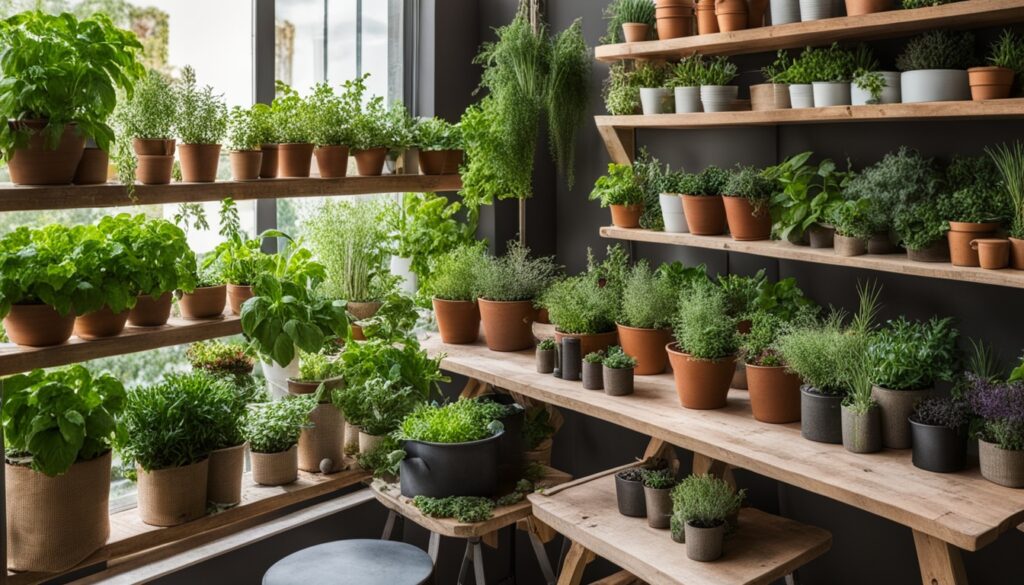
Soil and Light Requirements
Herbs do best in soil that drains well. If your garden soil is too heavy, add some sand or compost to help it drain better. For containers, choose terracotta pots. They’re not only pretty but also let excess water drain out.
While most herbs love the sun, some like a little shade, especially in hot places. Sage, for example, likes to cool off from the intense afternoon sun. When planning your garden, think about these needs:
- Full sun lovers: Basil, rosemary, thyme
- Partial shade fans: Mint, parsley, cilantro
Successful herb gardening is about watching and adjusting. Pay attention to your plants and they’ll show you what they need. With these tips, you’re all set to begin your exciting journey in herbal gardening!
Essential Herbs for Beginners
Starting your herbal garden journey? You’re in for a treat! Let’s explore some easy herbs for indoor gardening and the best herbs for small garden spaces. These beginner-friendly herbs will not only add flavor to your dishes but also bring a touch of green to your home.
Beginner-Friendly Herbs
Here’s a list of herbs perfect for new gardeners:
- Basil
- Rosemary
- Thyme
- Mint
- Oregano
- Parsley
- Cilantro
- Chives
- Dill
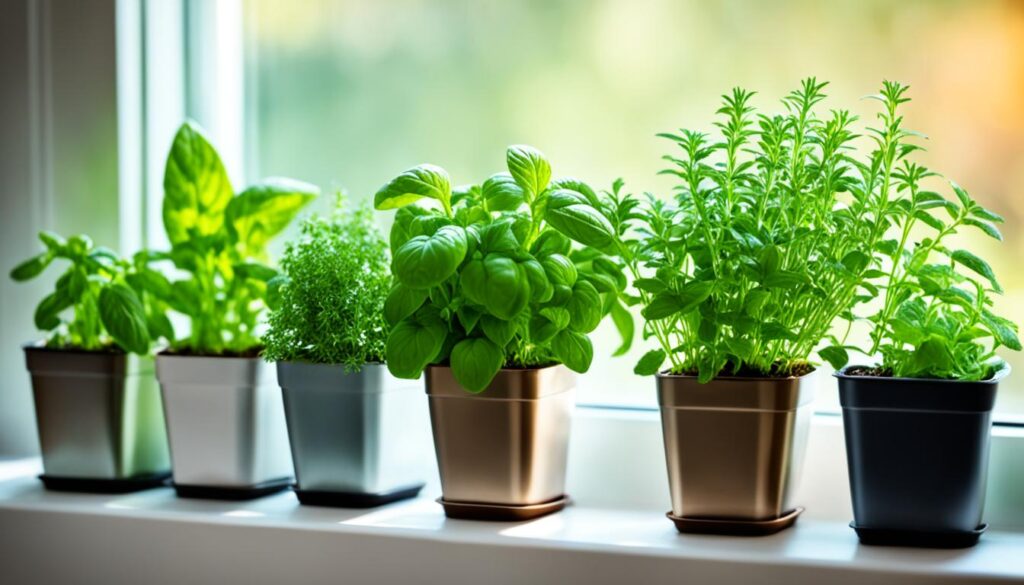
Herb Descriptions and Uses
Let’s dive into what makes these herbs special and how you can use them in your cooking:
| Herb | Description | Culinary Uses |
|---|---|---|
| Basil | Fragrant, sweet leaves | Italian dishes, pesto |
| Rosemary | Woody, needle-like leaves | Roasts, infused oils |
| Thyme | Small, delicate leaves | Soups, stews |
| Mint | Cool, refreshing flavor | Drinks, Mediterranean cuisine |
| Oregano | Strong, earthy taste | Pizza, tomato-based dishes |
These herbs are not only flavorful but also versatile. Parsley works great as a garnish, while cilantro adds zest to Mexican and Asian dishes. Chives bring a mild garlicky flavor, and dill pairs wonderfully with fish. With these easy herbs for indoor gardening, you’ll have a thriving herb garden in no time!
Planting and Caring for Your Herbs
Are you ready to start your herb garden? Let’s explore some easy DIY tips to help you begin. Creating a successful herb garden is simpler than you might think!
Step-by-Step Planting Guide
Here are the easy steps to plant your herbs:
- Choose well-draining soil for your herbs
- Ensure proper sunlight exposure for each herb variety
- Dig holes twice the size of the root balls
- Place herbs in holes and fill with soil
- Water thoroughly after planting
Watering, Fertilizing, and Pruning Tips
For healthy herbs, proper care is key. Water them regularly but don’t overdo it. Most herbs like the soil to be dry. Only fertilize a little, as they don’t need much. Prune them often to keep them bushy and prevent them from flowering, which can change their flavor.
| Herb | Watering | Fertilizing | Pruning |
|---|---|---|---|
| Basil | Every 3-4 days | Monthly | Weekly |
| Rosemary | When soil is dry | Rarely | As needed |
| Mint | Every 2-3 days | Monthly | Bi-weekly |
Each herb is different. Watch and adjust your care based on what you see and your garden’s conditions. With these tips, you’ll soon be enjoying fresh herbs!
Harvesting and Storing Herbs
Learning how to harvest and store fresh herbs can change your cooking and wellness routine. With the right methods, you can enjoy herbs all year. This will make your cooking better and your health remedies more effective.
When and How to Harvest Herbs
The best time to pick herbs is in the morning, after the dew is gone but before it gets too hot. This way, you get the best flavor and oil content. Cut stems just above a leaf intersection to help the plant grow more.
For leafy herbs like basil and cilantro, picking them often keeps the plant bushy and stops it from flowering.
Best Methods for Drying and Storing Herbs
Here are some ways to keep your herbs fresh:
- Fresh storage: Put cut herbs in water, cover with a plastic bag, and keep in the fridge.
- Drying: Hang herb bunches in a sunny spot until they are dry.
- Freezing: Chop herbs like chives and parsley, then freeze in ice cube trays with water or oil.
Some herbs, like tarragon, can be frozen or dried for later use. This gives you different ways to keep them.
| Herb | Best Preservation Method | Storage Duration |
|---|---|---|
| Basil | Freezing | Up to 6 months |
| Rosemary | Drying | Up to 1 year |
| Cilantro | Fresh in water | 1-2 weeks |
| Thyme | Drying or Freezing | Up to 1 year |
By learning these techniques, you’ll always have fresh flavors for your dishes and health goals all year.
Common Problems and Solutions in Herbal Gardening
Growing herbs can be rewarding, but it has its challenges. Let’s look at some common issues and herbal garden pest control tips to help your plants thrive.
Pests and Diseases to Watch Out For
Aphids and Japanese beetles often visit herb gardens. They can harm your plants if not controlled. Some herbs, like chives, can keep these pests away.
Basil is a popular herb but can face diseases. Wilts, leaf spots, and downy mildew can harm it. Keep plants well-spaced for good air flow to prevent these problems.
Troubleshooting Common Issues
Don’t overwater your herbs. This can cause root rot and damage them. Always check the soil moisture before watering.
Herbs like mint and oregano grow quickly. If not kept in check, they can take over your garden. Use containers for these herbs to control their spread.
Bolting is a problem for herbs like cilantro and dill. To avoid this, plant them in succession and harvest often. This way, you’ll have fresh herbs all season.
“The key to a thriving herb garden is vigilance. Observe your plants daily and address issues promptly.”
Knowing these common problems and solutions will help you keep your herb garden healthy and productive. Remember, gardening is a learning process. Don’t get discouraged by setbacks. With patience and practice, you’ll become an expert in herbal gardening.
Conclusion and Additional Tips
Growing your own herbal garden is a rewarding experience. It can change your cooking and wellness routine with fresh, homegrown herbs. By following the guide, you’ll get a thriving herb garden.
Recap of Key Points
Choose the right spot for your herbs, thinking about their needs. Plant them in soil that drains well and water them right. Harvesting often keeps your plants healthy and full of herbs.
Watch out for pests and diseases to spot problems early. This keeps your garden healthy.
Additional Tips for Success
Don’t hesitate to try new herb mixes in your cooking. Experiment with herbs like lemon balm or tarragon to improve your cooking. Companion planting helps your herbs and other plants in the garden.
Let some herbs flower to attract pollinators. This makes your garden healthier overall.
If you have little outdoor space, many herbs are great for indoor gardens. With the right care, your herbs can offer fresh flavors and natural remedies all year. Start small, learn as you go, and enjoy the world of homegrown herbs!
FAQ
What is herbal gardening?
Herbal gardening is about growing herbs for cooking, medicine, or just for their smell. It lets you have fresh herbs for your kitchen, natural cures, and scents right in your garden.
What are the benefits of growing your own herbs?
Growing your own herbs gives you fresh, tasty ingredients for cooking and natural health remedies. They fit well in small spaces, perfect for patios or indoor gardens. Plus, they’re easy to take care of, needing just sunlight and regular watering.
What are some essential herbs for beginners?
Beginners should start with herbs like basil, rosemary, thyme, mint, oregano, parsley, cilantro, chives, and dill. These herbs are versatile and can improve many dishes. They also have many uses in cooking and for making scents.
How do I choose the right location for my herb garden?
Herbs need at least 6 hours of sunlight a day, so pick a spot that gets plenty of sun. They also need well-draining soil to grow well. For containers, use terracotta pots to help with drainage.
How do I care for my herb plants?
Water your herbs often but don’t overdo it. They don’t need a lot of food, so fertilize lightly. Prune them often to keep them bushy and prevent them from flowering, which can change their taste. Make sure they have enough space and air to avoid diseases.
When and how should I harvest my herbs?
Harvest your herbs in the morning, after the dew has dried but before it gets too hot. Cut stems just above where a leaf meets another leaf. For herbs like basil and cilantro, pick them often to encourage more growth. You can store fresh-cut herbs in water or dry them for later use.
What are some common problems and solutions in herbal gardening?
Keep an eye out for pests like aphids and Japanese beetles. Too much water can cause root rot, and some herbs like mint and oregano can spread too much. If you’re growing cilantro and dill, they might bolt in the heat. Plant them in succession and pick them often to stop this.
Source Links
- https://franksnurseryandcrafts.com/12-essential-herbs-for-your-kitchen-garden/ – 12 Essential Herbs for Your Kitchen Garden – Franks Nursery
- https://homesteadingfamily.com/medicinal-herbs-their-uses/ – Medicinal Herbs & Their Uses
- https://mynortherngarden.com/2023/01/01/__easy-herbs-beginning-gardeners/ – Easy Herbs for Beginning Gardeners – My Northern Garden
- 10 Must-Have Blooms for Your 2025 Garden
- The Health Advantages of Gardening You Need to Know
- How to Create a Small Vegetable Garden Layout Plan: A Beginner’s Guide
- DIY Garden Projects for Small Spaces: Upcycling Ideas to Maximize Your Garden
- Watering Techniques for Small Gardens: Ensuring Your Plants Thrive
- Small Border Plants for Landscaping: Adding Beauty and Functionality to Your Garden
- Year-Round Small Space Gardening: Seasonal Planting Tips for Maximum Harvest
- Essential Tools for Small-Space Gardening: What You Really Need
- The Ultimate Guide to Container Vegetables: What to Grow in Small Spaces
- Budget-Friendly Gardening: How to Create a Thriving Garden on a Tight Budget
- How to Optimize Sunlight in Small Gardens: Tips for Better Plant Growth
- DIY Vertical Planters: Creative Ideas for Small Space Gardening
- Companion Planting for Small Vegetable Gardens: Boost Growth and Deter Pests
- Container Gardening Essentials: Choosing the Right Pots, Soil, and Plants
- Vertical Gardening Techniques: Maximizing Your Small Space with Climbers and Vines
- How to Build a Raised Bed Garden in a Small Backyard: Step-by-Step Guide
- The Best Vegetables for Small-Space Gardens: High-Yield Varieties You Need to Grow
- Smart Vegetable Garden Layouts for Small Spaces: Maximizing Your Green Thumb in Compact Areas
- 40. Best Practices for Managing a Sustainable Garden Year-Round
- Building a Wildlife Pond for Biodiversity
- Advanced Techniques in Sustainable Gardening
- How to Create a No-Till Garden
- The Mental Health Benefits of Gardening
- Using Technology to Enhance Sustainable Gardening
- Getting Certified Organic: Steps and Benefits
